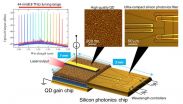How Microprocessor precisely initiates miRNA production
2015-06-02
(Press-News.org) A scientific group from the Center for RNA Research within the Institute for Basic Science (IBS) and School of Biological Sciences in Seoul National University has reported an insightful molecular mechanism of how Microprocessor, the DROSHA-DGCR8 complex, precisely determines cleavage sites on miRNA-containing primary transcripts allowing faithful initiation of microRNA biogenesis.
The group's findings, published in Cell on 28th May as Advance Online Publication, not only reveal the function of each part of human Microprocessor, but also outline future work on the molecular structure of the protein complex which will enable various new applications of RNA interference technology in basic research and human therapeutics.
MicroRNAs (miRNAs) are short RNA species of ~22 nucleotides, but play critical roles in a wide variety of cellular processes, including stem cell differentiation and tumorigenesis. Their gene silencing mechanism is dependent on their sequences which are acquired through the miRNA production process, called miRNA biogenesis. This process is initiated in the nucleus by Microprocessor, a complex of the catalytic subunit DROSHA and a co-factor DGCR8, which cleaves primary transcripts (pri-miRNAs) containing miRNA sequences. It is thought that the pri-miRNA processing step determines the sequences of miRNAs and thereby their actions, thus it is greatly important to understand how Microprocessor accurately process pri-miRNAs.
A group of researchers in IBS and SNU led by Dr. Jae-Sung Woo and Dr. V. Narry Kim have made a significant advance toward understanding the molecular mechanism of pri-miRNA processing by using highly pure recombinant Microprocessor which was lacking in this field. They discovered that Microprocessor consists of one DROSHA and two DGCR8 molecules. They also disclosed an important and surprising role of DROSHA as a "molecular ruler" by showing that DROSHA can recognize the ssRNA-dsRNA junction at the lower side of pri-miRNA and measure the distance of ~11 base pairs from the junction to find the precise cleavage sites. DROSHA was also found to specifically recognize the UG motif located at the lower junction, allowing it to interact with pri-miRNAs more specifically. Over the previous knowledge, DGCR8 was found to have three functionally distinct parts: the tail to stabilize DROSHA, the body to enhance the processing efficiency by recruiting pri-miRNA, and the head to ensure the processing accuracy by recognizing the upper elements of pri-miRNA including the apical UGU motif.
Dr. Nguyen T. A., the first author of this paper, has integrated various biochemical, biophysical, and bioinformatical data and proposed a current model showing that the functional parts of Microprocessor interact with the cis-acting elements on pri-miRNA for accurate processing. This model also represents an interesting molecular mechanism of the Microprocessor orientation on pri-miRNAs which has been unknown so far. Furthermore, it brings out a comprehensive understanding how Microprocessor acts differently on various pri-miRNA substrates with different sequence and structural features, and clarify decade-standing controversies over the pri-miRNA processing mechanism.
INFORMATION:
ELSE PRESS RELEASES FROM THIS DATE:
2015-06-02
Bariatric surgery does not only benefit the health of patients who undergo this weight loss procedure. It also leads to greater intimacy between them and their life partners, and adds a spark to their sex life. It's all in all a shared journey that brings partners closer together, says Mary Lisa Pories of East Carolina University in the US, lead author of a study providing insights into the experience of couples after one of the partners underwent weight loss surgery. The findings are published in Springer's journal Obesity Surgery.
Bariatric surgery is the most effective ...
2015-06-02
SALT LAKE CITY - Intermountain Healthcare is one of 150 organizations in the nation that was invited to the White House to help develop national policy to address the growing problem of the overuse of antibiotics.
Intermountain has been studying this issue extensively for the past several years and is one the of leading healthcare organizations in the United States to research best practices to help curb the inappropriate use of antibiotics, which is contributing to the growing problem of resistant bacteria.
Intermountain will participate in a one-day antibiotic stewardship ...
2015-06-02
BOSTON - A new study from researchers at Beth Israel Deaconess Medical Center (BIDMC) suggests that risk factors for readmission change significantly over the course of the 30 days following hospital discharge. Thirty-day hospital readmission rates have become a federal quality metric intended to reflect inpatient quality of care and unnecessary health care utilization.
Published today in the Annals of Internal Medicine, the research suggests that two distinct 8-day and 30-day readmission rates would serve as better inpatient quality measurements and would better inform ...
2015-06-02
The scientific team, from the Institute for Basic Science (IBS) and Seoul National University, has developed an ultra-thin wearable quantum dot light emitting diodes (QLEDs). The electronic tattoo is based on current quantum dot light emitting diode (QLED) technology. Colloidal quantum dot (QLED's) have attracted great attention as next generation displays. The quantum dots (QDs) have unique properties such as the color tunability, photo/air stability, and are printability on various substrates. The device is paper thin and can be applied to human skin like a sticker.
The ...
2015-06-02
To arrange for an interview with a researcher, please contact the Communications staff member identified at the end of each tip. For more information on ORNL and its research and development activities, please refer to one of our media contacts. If you have a general media-related question or comment, you can send it to news@ornl.gov.
SOLAR - Suitability mapping ...
Using remote sensing data, researchers can efficiently determine optimum sites for solar power plants, according to a study led by Olufemi Omitaomu of Oak Ridge National Laboratory. With the target of solar ...
2015-06-02
University of Adelaide researchers have discovered cerebral palsy has an even stronger genetic cause than previously thought, leading them to call for an end to unnecessary caesareans and arbitrary litigation against obstetric staff.
In an authoritative review published in the American Journal of Obstetrics & Gynecology, members of the Australian Cerebral Palsy Research Group, based at the University of Adelaide's Robinson Research Institute, argue that up to 45% of cerebral palsy cases can have genetic causes.
This builds on research published in February this year ...
2015-06-02
A study of marine mammals and other protected species finds that several once endangered species, including the iconic humpback whale, the northern elephant seal and green sea turtles, have recovered and are repopulating their former ranges.
The research, published in the June edition of Trends in Ecology and Evolution, suggests that some species, including humpback whales, have reached population levels that may warrant removal from endangered species lists.
But returning species, which defy global patterns of biodiversity loss, create an urgent new challenge for policymakers ...
2015-06-02
Researchers at Tohoku University and the National Institute of Information and Communications Technology (NICT) in Japan, have developed
a novel ultra-compact heterogeneous wavelength tunable laser diode. The heterogeneous laser diode was realized through a combination
of silicon photonics and quantum-dot (QD) technology, and demonstrates a wide-range tuning-operation.
The researchers presented their work at a Conference on Lasers and Electro-Optics (CLEO) in San Jose, California, on May 13. The related
paper was also be published in Applied Physics Express ...
2015-06-02
A research group at Tohoku University has succeeded in fabricating an atomically thin, high-temperature superconductor film with a superconducting transition temperature (Tc) of up to 60 K (-213°C). The team, led by Prof. Takashi Takahashi (WPI-AIMR) and Asst. Prof. Kosuke Nakayama (Dept. of Physics), also established the method to control/tune the Tc.
This finding not only provides an ideal platform for investigating the mechanism of superconductivity in the two-dimensional system, but also paves the way for the development of next-generation nano-scale superconducting ...
2015-06-02
An international team led by Thayne Currie of the Subaru Telescope and using the Gemini South telescope, has discovered a young planetary system that shares remarkable similarities to our own early solar system. Their images reveal a ring-like disk of debris surrounding a Sun-like star, in a birth environment similar to the Sun's. The disk appears to be sculpted by at least one unseen solar system-like planet, is roughly the same size as our solar system's Edgeworth-Kuiper Belt (commonly called the Kuiper Belt), and may contain dust and icy particles. This work provides ...
LAST 30 PRESS RELEASES:
[Press-News.org] How Microprocessor precisely initiates miRNA production



